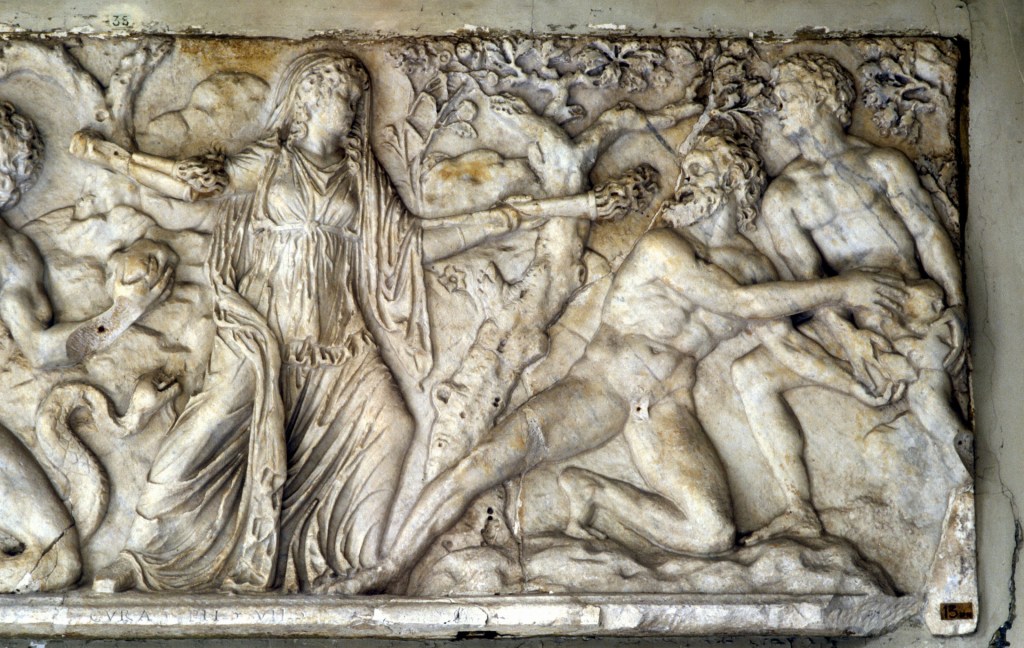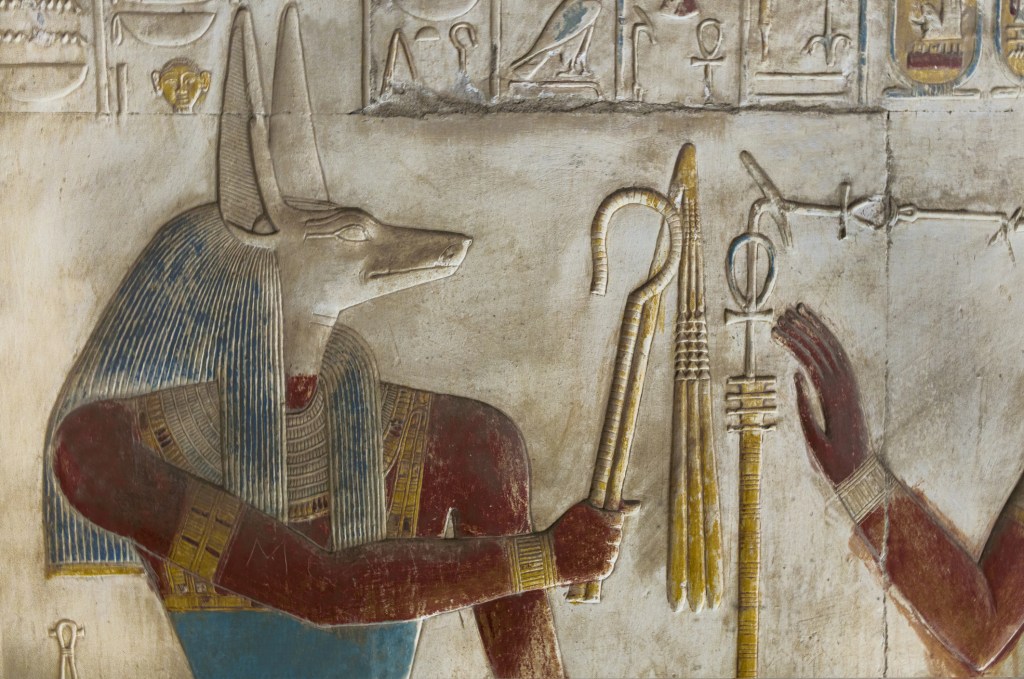We’re believers in the power of the palindrome, so of course we can’t help but wag our tails knowing “dog” spelled backward is “god.” This linguistic quirk may stem from the longstanding presence of our canine companions in legends and folklore. Throughout history, various cultures have revered canine gods and dogs in mythology. These tales remind us of dogs’ profound impact on our human histories. Here are some of the most legendary mythological dogs and dog-loving deities.
Hecate and Cerberus (Ancient Greece)

In Greek mythology, Hecate is the goddess presiding over crossroads, doorways, and canines among her myriad domains. Often depicted with three heads, her visage may encompass those of cows, horses, boars, serpents, or dogs — an amalgamation that might seem perplexing, if not outright headache-inducing.
Descriptions of Hecate frequently portray her either as a mythological dog or as a dog-loving deity. Depictions show the fierce goddess accompanied by her loyal canines, with their barks or howls heralding her presence. Given the historical use of dogs in ancient Greece for safeguarding homes and perimeters, her association with entryways where vigilant dogs would stand watch appears fitting and unsurprising.
Another mythological dog is the three-headed guardian of the underworld, Cerberus. Though feared by the ancient Greeks, J.K. Rowling reimagined the formidable creature to protect the Sorcerer’s Stone in the inaugural Harry Potter installment, aptly named Fluffy.
Gula (Ancient Babylon)

Gula, also recognized by the moniker Bau or the lengthier Nintinugga, among many other titles, stands as one of the prominent goddesses within the Babylonian pantheon. She often graces boundary stones and is portrayed near dogs in artistic renderings. Within her temples, mythological dogs roamed freely, with devout followers crafting dog statues as offerings in her honor. As Gula’s esteemed animal companion, the presence of dogs in art dedicated to or featuring her holds profound significance.
Gula also held sway over healing rites, earning her the epithet “the great healer.” Ancient beliefs may have linked this association to the observed phenomenon of dogs licking wounds, purportedly aiding in faster recovery. Though modern wisdom advises against such practices, the comfort derived from canine companionship remains a timeless source of solace in times of distress.
Anubis (Ancient Egypt)

If you’re familiar with any ancient Egyptian deities, chances are Anubis is one of them. Instantly recognizable by his distinctive jackal head, Anubis is pivotal in ushering souls into the afterlife. He is also tasked with the solemn duty of weighing a person’s heart to determine their eligibility for passage to the realm of the deceased.
The link between Anubis and death likely stems from the observation of jackals frequenting gravesites and cemeteries. As scavengers, their appearance evoked unease, as they were known to disturb shallow graves in search of sustenance. As a result, their presence adds an eerie layer to the ambiance of burial grounds. If you were to catch a glimpse of a jackal prowling at night, perhaps you were witnessing the god Anubis accompanying the souls of the dead to the afterlife.
Coyote (Native American)

Within Native American traditions, Coyote typically embodies an anthropomorphic trickster deity. This mythological dog-like deity mirrors the cunning and sly nature of the coyote that shares his name. Legends surrounding Coyote span diverse cultures and tribes, yet a common thread depicts him as mischievous, often drawing parallels to the trickster archetype embodied by figures like the Norse god Loki. The eerie laughter-like cries emitted by coyotes may contribute to such associations.
Myths attribute various exploits to Coyote, including impersonating the Creator and perpetrating the first lie. His enduring presence in storytelling also serves to impart cultural teachings to younger generations, offering insights into Native American beliefs and values that persist to this day.
Xolotl (Aztec)

Xolotl, a prominent figure in Aztec mythology, holds sway over domains encompassing lightning, fire, and the realm of death. Depictions of him vary, ranging from a skeletal figure to a monstrous being. Sometimes, he’s also shown as a man adorned with a dog’s head.
Frequenting the underworld, Xolotl also assumes the role of guardian over the sun as it descends beneath the horizon each night. Similarly, this duty coincides with his responsibility of ushering the spirits of the deceased into the realm below.
Notably, Xolotl also played a pivotal role alongside the god Quetzalcoatl in facilitating the conveyance of fire from the underworld to the living world. Xolotl’s name lives on not only in myth but also in the breed known as the Xoloitzcuintli. Often, this breed is referred to as the Mexican Hairless Dog.
Loki and Fenrir (Norse)
Though we often like to believe that all dogs are inherently good, there are instances where even the most headstrong pups require help with training. What’s more, sometimes dogs and their wolf brethren lean into hellhound territory. In Norse mythology, Loki and Fenrir stand as formidable figures. Loki, the trickster god, is renowned for his cunning and mischief. Maybe you’re familiar with Marvel’s Loki, where his elaborate schemes often stir discord among the gods.
Despite his erratic nature, he remains integral to the Norse pantheon. Along with his wolf companion Fenrir, this dynamic duo plays a pivotal role in many myths and legends. Fenrir is foretold to bring the great calamity during Ragnarök, also known as the world’s end in Norse cosmology. Bound by the gods in an attempt to forestall his prophesied role, Fenrir exudes an aura of power. As such, this mythological dog symbolizes the inevitability of chaos and destruction. We can already assume Fenrir rarely listens to “sit” or “down!”
Mythological names for dogs
If you’re considering welcoming a dog into your family, you may wish to select a name that reflects their strength and grace. A mythological dog name for your pup might be just the place to start!
Devotion isn’t just for deities, of course. While your faithful dog may not guard the spirits of the underworld, their presence undoubtedly merits a cherished spot within the household. Even more than a mythological dog of legend, devoted dogs transcend divinity to become beloved members of our families.









